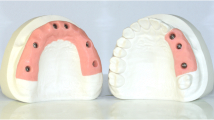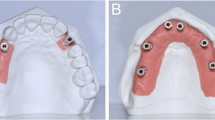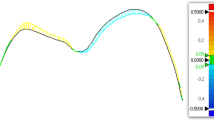Abstract
Objectives
Direct and indirect digitalization offer two options for computer-aided design (CAD)/ computer-aided manufacturing (CAM)-generated restorations. The aim of this study was to evaluate the accuracy of different intraoral scanners and compare them to the process of indirect digitalization.
Material and method
A titanium testing model was directly digitized 12 times with each intraoral scanner: (1) CS 3500 (CS), (2) Zfx Intrascan (ZFX), (3) CEREC AC Bluecam (BLU), (4) CEREC AC Omnicam (OC) and (5) True Definition (TD). As control, 12 polyether impressions were taken and the referring plaster casts were digitized indirectly with the D-810 laboratory scanner (CON). The accuracy (trueness/precision) of the datasets was evaluated by an analysing software (Geomagic Qualify 12.1) using a “best fit alignment” of the datasets with a highly accurate reference dataset of the testing model, received from industrial computed tomography.
Results
Direct digitalization using the TD showed the significant highest overall “trueness”, followed by CS. Both performed better than CON. BLU, ZFX and OC showed higher differences from the reference dataset than CON. Regarding the overall “precision”, the CS 3500 intraoral scanner and the True Definition showed the best performance. CON, BLU and OC resulted in significantly higher precision than ZFX did.
Conclusions
Within the limitations of this in vitro study, the accuracy of the ascertained datasets was dependent on the scanning system. The direct digitalization was not superior to indirect digitalization for all tested systems.
Clinical relevance
Regarding the accuracy, all tested intraoral scanning technologies seem to be able to reproduce a single quadrant within clinical acceptable accuracy. However, differences were detected between the tested systems.





Similar content being viewed by others
References
Rubel BS (2007) Impression materials: a comparative review of impression materials most commonly used in restorative dentistry. Dent Clin N Am 51:629–642 vi
Christensen GJ (2005) The state of fixed prosthodontic impressions: room for improvement. J Am Dent Assoc 136:343–346
Christensen GJ (2008) Will digital impressions eliminate the current problems with conventional impressions? J Am Dent Assoc 139:761–763
Mehl A, Ender A, Mormann W, Attin T (2009) Accuracy testing of a new intraoral 3D camera. Int J Comput Dent 12:11–28
Henkel GL (2007) A comparison of fixed prostheses generated from conventional vs digitally scanned dental impressions. Compend Contin Educ Dent 28:422–424 426-428, 430-421
Syrek A, Reich G, Ranftl D, Klein C, Cerny B, Brodesser J (2010) Clinical evaluation of all-ceramic crowns fabricated from intraoral digital impressions based on the principle of active wavefront sampling. J Dent 38:553–559
Ender A, Mehl A (2013) Accuracy of complete-arch dental impressions: a new method of measuring trueness and precision. J Prosthet Dent 109:121–128
Ender A, Mehl A (2013) Influence of scanning strategies on the accuracy of digital intraoral scanning systems. Int J Comput Dent 16:11–21
Luthardt RG, Loos R, Quaas S (2005) Accuracy of intraoral data acquisition in comparison to the conventional impression. Int J Comput Dent 8:283–294
Almeida E, Silva JS, Erdelt K, Edelhoff D, Araujo E, Stimmelmayr M, Vieira LC, et al. (2014) Marginal and internal fit of four-unit zirconia fixed dental prostheses based on digital and conventional impression techniques. Clin Oral Investig 18:515–523
Seelbach P, Brueckel C, Wostmann B (2013) Accuracy of digital and conventional impression techniques and workflow. Clin Oral Investig 17:1759–1764
Accuracy (trueness and precision) of measurement methods and results—part 1: general principles and definitions (ISO 5725–1:1994)
Keul C, Stawarczyk B, Erdelt KJ, Beuer F, Edelhoff D, Guth JF (2014) Fit of 4-unit FDPs made of zirconia and CoCr-alloy after chairside and labside digitalization—a laboratory study. Dent Mater 30:400–407
Guth JF, Keul C, Stimmelmayr M, Beuer F, Edelhoff D (2013) Accuracy of digital models obtained by direct and indirect data capturing. Clin Oral Investig 17:1201–1208
Ender A, Mehl A (2011) Full arch scans: conventional versus digital impressions—an in-vitro study. Int J Comput Dent 14:11–21
Ender A, Mehl A (2015) In-Vitro evaluation of the accuracy of conventional and digital methods of obtaining full-arch dental impressions. Quintessence Int 46:9–17
Nedelcu RG, Persson AS (2014) Scanning accuracy and precision in 4 intraoral scanners: an in vitro comparison based on 3-dimensional analysis. J Prosthet Dent 112:1461–1471
Ueda K, Beuer F, Stimmelmayr M, Erdelt K, Keul C, Guth JF (2015) Fit of 4-unit FDPs from CoCr and zirconia after conventional and digital impressions. Clin Oral Investig
Acknowledgments
The authors would like to thank all manufacturers of the scanning systems (Carestream Health Inc., Zfx GmbH, Sirona Dental Systems, 3M and 3shape) for their support during the study and for the providence of open STL data for the analysis.
Author information
Authors and Affiliations
Corresponding author
Ethics declarations
Conflict of interest
Dr. Güth reports research grants and honorarium for scientific lectures from 3M, Sirona and Zfx outside the submitted work. Cornelius Runkel, Dr. Keul and Dr. Stimmelmayr report no conflict of interest. Prof. Edelhoff reports research grants and honorarium for scientific lectures from 3M outside the submitted work. Prof. Beuer reports personal grants from Sirona outside the submitted work. The authors have full control of all primary data and they agree to allow the journal to review their data if requested.
Funding
The research was supported by the Department of Prosthetic Dentistry, Ludwig Maximilian University Munich, Germany.
Ethical approval
This article does not contain any studies with human participants or animals performed by any of the authors.
Informed consent
For this kind of study formal consent is not required. The manuscript does not contain clinical studies or patient data.
Rights and permissions
About this article
Cite this article
Güth, JF., Runkel, C., Beuer, F. et al. Accuracy of five intraoral scanners compared to indirect digitalization. Clin Oral Invest 21, 1445–1455 (2017). https://doi.org/10.1007/s00784-016-1902-4
Received:
Accepted:
Published:
Issue Date:
DOI: https://doi.org/10.1007/s00784-016-1902-4




